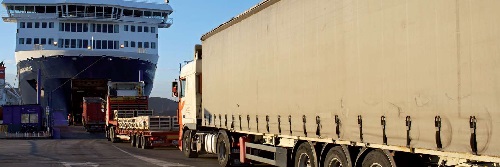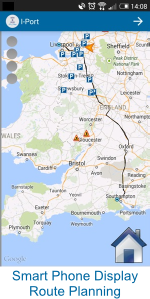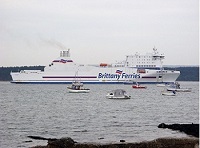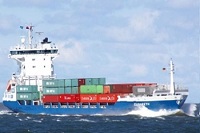

Between 2000 and 2015, Sollerta Ltd carried out a number of multimodal studies, mainly in collaboration with or as a subcontractor to Marine South East in contracts awarded by the European Commission. Sollerta was wound up as a company in February 2015, but former directors of Sollerta are keeping the domain open for the time being to offer to the wider logistics community the benefit of our studies and expertise.
In the 1950's Malcolm McLean, a trucking entrepreneur from South Carolina, developed a simple vision - to put trailer-size loads of goods into standard sized containers to enable them to be moved between trucks, trains and ships without breaking bulk. Turning that idea into real-life business practice required many additional innovations and there was a long struggle before it was widely adopted.
Containerisation made possible the idea of a seamless transport of goods from factory to the exit port, from exit port to the destination port, and then by road or rail to the warehouse or customer. Containerisation has brought about a sharp fall in transportation costs with sweeping economic consequences.
Peter L. Bernstein, author of Against the Gods: The Remarkable Story of Risk has said
"The experts who tell you the transistor and microchips changed the world are off base. The ugly, unglamorous, little-noticed shipping container has changed the world. Without it, there would be no globalization, no Wal-Mart, maybe even no high-tech. And what looks like low-tech is in fact a breathtaking technological innovation."
However, the search for reducing delivery costs continues. The maritime industry has identified inland logistics as one of the most vital areas still left to cut costs. It has been estimated that the proportion of inland costs relative to the total transportation costs of a container shipping ranges from 40% to 80%.
The focus has switched accordingly to problems such as:
How best to facilitate the transfer of boxes from ship to the inland transport mode (road or rail).
How best to use road and rail, given that both road and rail networks in the UK are currently operating at their maximum loads.
The large number of modern container ships entering the relatively few deep water ports will result in congestion in the hinterland surrounding those ports. How best can we mitigate this?
Given that the cheapest mode of transport by far is the sea, how do we minimise the distances travelled by land.
Given that the UK does a large amount of trade with mainland Europe, could short sea shipping be an economically viable alternative to the much used Dover-Calais crossing?
Multimodal logistics addresses these issues, which are increasingly relevant as Governments and Industry begin to recognise the need to reduce energy consumption and hence carbon dioxide emissions.
Comparing costs of Roll on - Roll off (RORO) multimodal routes in Europe

As part of the PROPOSSE study, Sollerta developed a web based application to compare the cost of transporting goods between UK, Ireland and Mainland Europe, with UK exit ports along the South cost for transport into mainland Europe and along the west coast of England Wales and Scotland for transport to and from Ireland.
The application takes into account
Road distances in UK, Ireland and Mainland Europe
The price of fuel
The running costs of different types of lorry, based on data from the Road Haulage Association
Freight Ferry crossing times and fares
The EU directive which limits the time spent driving per day and insists on defined break times and overnight breaks
The application is written in Javascript and uses Google maps extensively. The application calculates the costs of transporting a truckload between start and end points in the UK, Ireland or Mainland Europe and shows the routes.
A description of the application is given in this presentation
The application was called Truckdriver but has now been changed to JourneyPlan.
JourneyPlan can be accessed via this link
Extensions to this utility currently planned are
- Add allowance for Motorway Tolls (Péage)
- Add allowance for Eco-taxe on French roads
- Integrate Ferry timetables and waiting time for embarkation
- Provide a comprehensive set of Ferry Fares for different types of vehicle
- Add railway routes and treat railway inland terminals as 'exit ports'
i-PORT a new IT service for optimising Intermodal Container Transport in European Ports

i-PORT is a pan-European project, based on collaboration between the European Space Agency, Aimes Grid Services and Avanti Communications, Ports including the port of Liverpool and several Shipping Lines and Container Hauliers. Deployment will commence during 2015 within the UK and Germany.
The project aims to create a cloud based communications infrastructure that will further optimise the passage of intermodal freight imports and exports through European Ports.
Truck Drivers approaching a port will have automatic communication with the Port's Vehicle Booking System via a smart phone in the cab. Any delays arising from traffic congestion and/or bad weather can be communicated to the VBS and the time slot adjusted. The smart phone will also offer the driver other facilities such as HGV routes, warning of traffic problems, recording of jobs and so on.
The project is being led by Container Port Ltd, a company created to provide leading edge software and services to the container transport industry and to improve transportation processes throught the use of mobile computing.
A recent paper published in Focus, the journal of Chartered Institute of Logistics and Transport (CILT) describes the application and its capabilities. You can download a copy of the paper here
Studies of Lift On - Lift Off (LOLO) Multimodal Operations
LOLO could offer considerable cost savings on the sea route as can be seen by comparing the types of ship that are used for RORO and LOLO modes

A freight ferry is a complex ship, with high capital cost, and high running cost. One of the largest freight ferries currently in service is the MV Cotentin (Fig 3) with a displacement of over 20,000 tonnes. This vessel has a crew of about 50.
The vessel carries about 120 lorries and their trailers with accommodation for the drivers and also supports to their needs at sea. A ship of this complexity has a high capital cost and a high running cost.
However, the RORO multimodal approach has a big advantage in being easy to manage, with the container beig under the control of a single company throughout its journey.

A short sea feeder ship is by contrast relatively simple in design and requires only a small crew to run it. Ship such as these have a lower capital cost and lower running cost.
The ship illustrated, the MV Elisabeth is 5000 Gross tonnes and can carry 650 TEU.
The fare for the sea crossing, say between a UK port and Northern Spain should therefore be a fraction of the cost of transporting an articulated lorry with driver via a freight ferry.
However, the problem is the coordination of the tasks required to deliver the container to the port and onto the ship then at the receiving port, to unload the container and transport it t its ultimate destination. There are organisations that have to work together to achieve a reliable and efficient process. And there is the question of who bears responsibility for the door to door delivery
.In 2013, Sollerta presented a paper at Antwerp conference on Short Sea Shipping which described ideas of how LOLO might be implemented to provide a reliable efficient service for short sea journeys within Europe. This paper, entitled MOTORWAYS OF THE SEA (Can we turn Pipedreams into Reality?) may be downloaded here